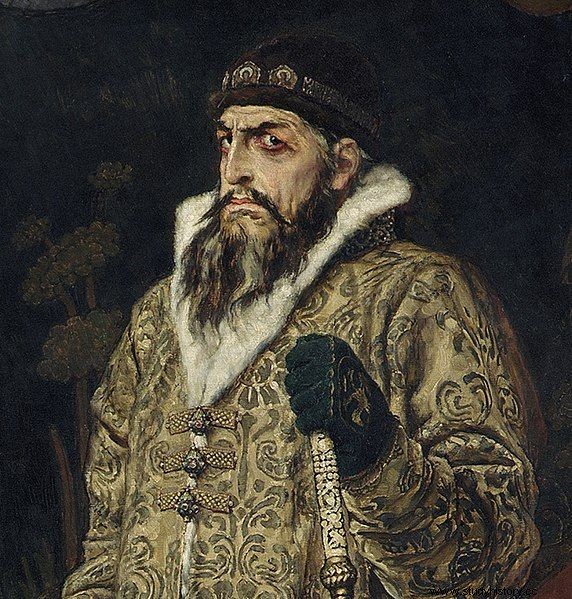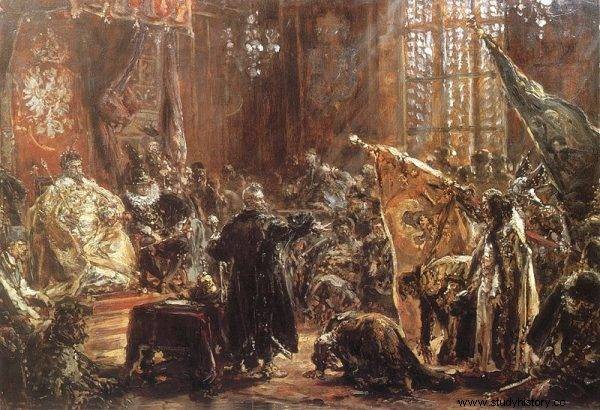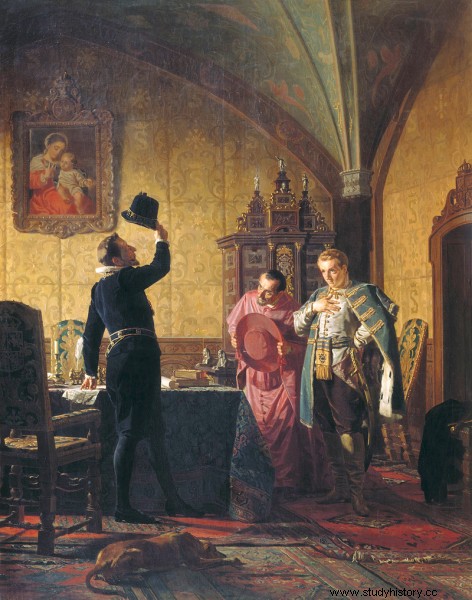In the 16th-17th centuries there were many plans for the Polish-Russian union. This meant that the Russian tsar could sit on the Polish throne, or the Russian - the Polish king.
The idea of merging the two countries first appeared during the interregnum, after the death of Sigismund Augustus in 1572. Interestingly, Moscow diplomacy began to prepare the ground for such a solution in the 1660s. The Russians concluded that a sick and childless king would need a suitable successor.
Attempt number one failed
At the beginning, these plans only included the Lithuanian throne, but after the conclusion of the Union of Lublin in 1569, the situation changed. When instead of two different countries, although with one monarch from the Jagiellonian dynasty at its head, one unified country appeared, the tsar came to the conclusion that he could take power in both Lithuania and Poland.
Many Polish politicians, as well as Protestants living in the Republic of Poland, strongly supported the idea of a union with Moscow. The residents of Lithuania were also in favor of this solution, reasoning as follows:

Ivan IV the Terrible
"If the Tsar of Moscow had become the King of Poland and Grand Duke of Lithuania, the Republic of Poland would be transformed into a tripartite federation. The Lithuanians could then enlist the support of the Russians to combat the excessive demands of the Poles . Or they would establish cooperation with the Polish side in order to gradually expand Polish and Lithuanian political, economic and cultural influences in Russia ”.
There was an idea for Zygmunt August to adopt Ivan, son of Ivan the Terrible.
As you know, there was an interregnum after the death of Sigismund Augustus. At that time, a large part of the Polish nobility still wanted to unite the Commonwealth with the huge Moscow state by electing Ivan the Terrible or his older son, Fyodor, to the throne. Russian historian Natalia Ejl`bart believes that then " a powerful Slavic empire would be created, which neither the Muslim East nor the Habsburgs could oppose, let alone Sweden . Poland would have avoided partitions, and Russia would have started its Europeanization much earlier ”. But Stefan Batory was elected king…
Attempt number two - consecutive failure
Stefan Batory was an active opponent of Moscow, which was a disaster for Russian diplomacy. Another chance for the unification of Russia with the Republic of Poland appeared after his death. Moscow was afraid that the Poles would choose the Swedish prince Sigismund, son of King Jan III, as the new ruler. After the death of his father, Zygmunt would receive the Swedish throne. "Then he would unite in his person two opponents of Moscow at the same time:the Republic of Poland and Sweden" - reasoned Russian diplomats.
There was only one way to bypass this danger - to achieve a Russian-Polish union instead of a Swedish-Polish union. Boris Godunov decided to put forward the candidacy of Tsar Fyodor Ivanovich, son of Ivan the Terrible, in the Polish royal elections . The already mentioned Swedish prince Sigismund and the Austrian Archduke Maksymilian also claimed the Polish throne.

Stanisław Żółkiewski presents the Szujski tsars at the Warsaw Sejm of 1611
The Tsar of Russia supported a large part of the Polish and Lithuanian nobility. However, the magnates made a mandatory condition for the election of Fyodor - the union of the Orthodox Church and the Catholic Church. Of course, this requirement was impossible, so Sigismund III of the Vasa dynasty became the king.
Attempt three - Dimitriads
In the 17th century, Władysław, son of Zygmunt III and future king Władysław IV, sat on the Moscow throne. It should be noted, however, that Prince Władysław held this position only formally.
In order to understand the backstage of the reign of Władysław IV, one should go back several years. In 1602, Grigory Otriepjew, who pretended to be the miraculously surviving son of Ivan the Terrible, who died in 1584, was in the Polish-Lithuanian Commonwealth and intended to seize power in Russia. In order to implement this plan, he needed support, primarily military. He decided to look for him with the Polish king Zygmunt III.
The intermediary between the monarch and Otriepjew was the voivode of Sandomierz, Jerzy Mniszech, who quickly caught a good deal. He proposed to the Russian that in exchange for intercession with the king, he would marry his daughter Maryna, make her a Moscow Tsarina, and the mother-in-law would pay a million rubles from the Moscow treasury . Otriepjew agreed to Jerzy's conditions. If Samozwaniec took power in Russia, Poland would also benefit from it, because the young ruler would give the king the Smolensk and Severodsk regions (the latter included the Czernichów, Kursk and Orłowska governorates), over which Moscow and Warsaw have long been in dispute. In the spring of 1604, Sigismund III agreed to prepare Polish troops for a military expedition.

Dmitri Samozwaniec I swears to Sigismund III Vasa to introduce Catholicism in Russia
Then Dymitr Samozwaniec went to Sambor, the residence of the Mniszech family, where he became engaged to Maryna. On May 25, 1604, George and Otriepjew signed a final agreement on the marriage and began gathering troops for the march to Moscow. They managed to collect 5,500 people. On August 25, 1604, on the day of the Assumption of the Most Holy Mother of God, Dmitri left for Russia. Although the project initiated by Samozwaniec looked utopian, Otriepjew realized his plan - on August 20, 1605, he entered the Kremlin surrounded by the Polish army .
Tsar Dmitri's coronation took place a few days later. At the same time, Maryna's wedding expedition, who left for Moscow in March 1606, was being prepared in the Sambor castle. On May 8 that year, the wedding of a Polish woman and Dymitr took place. Wojewodzianka ruled only 9 days because her husband was brutally murdered. Maryna, however, wanted to return to the Moscow throne and soon began a struggle for power.
After the murder of Dimitri, Prince Wasyl Shujski was proclaimed the next tsar. His position in the country was shaky because many Russians did not believe in the death of the Self-Prophet. Sigismund III decided to take advantage of the chaos in Russia. Therefore, when in 1607 an unknown individual appeared in Staroduba claiming that he was a miraculously surviving Dimitri, the king expressed his support for him . In November 1609, to the Łża-Dymitr camp, because this resurrected tsar entered history under this name, the Polish legation arrived in Tuszyn, which submitted a proposal for a union between the Polish-Lithuanian Commonwealth and Russia. In February 1610, Prince Władysław was elected tsar at the behest of some boyars, and a Polish military intervention took place in Russia itself.
The election of the prince to the Moscow monarch was to seal the Polish-Russian union. Coins with the image of the new tsar were even minted in Russia. But in exchange for putting Władysław on the throne, the Russian side set one condition for Sigismund III - the prince was to convert to Orthodoxy in order to gain the favor of his subjects. The Polish king did not consent.
Ultimately, the question of the Russian throne was closed in February 1613, when the boyars elected Mikhail Romanov as tsar. At that time, Poles had already been driven out of the Kremlin.
